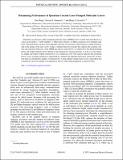| dc.contributor.author | Wang, Fan | |
| dc.contributor.author | Johnson, Steven G | |
| dc.contributor.author | Everitt, Henry O. | |
| dc.date.accessioned | 2021-08-25T14:12:58Z | |
| dc.date.available | 2021-08-25T14:12:58Z | |
| dc.date.issued | 2021-08 | |
| dc.date.submitted | 2021-01 | |
| dc.identifier.issn | 2331-7019 | |
| dc.identifier.uri | https://hdl.handle.net/1721.1/131198 | |
| dc.description.abstract | Quantum-cascade-laser- (QCL) pumped molecular lasers (QPMLs) have recently been introduced as a source of powerful (>1 mW) tunable (>1 THz) narrow-band (<10 kHz) continuous-wave terahertz radiation. The performance of these lasers depends critically on molecular collision physics, pump saturation, and on the design of the laser cavity. Using a validated three-level model that captures the essential collision and saturation behaviors of the QPML gas nitrous oxide (N₂O), we explore how the threshold pump power and output terahertz power depend on the pump power and gas pressure, as well as on the diameter, length, and output-coupler transmissivity of a cylindrical cavity. The analysis indicates that maximum power occurs as pump saturation is minimized in a manner that depends much more sensitively on pressure than on cell diameter, length, or transmissivity. A near-optimal compact laser cavity can produce tens of milliwatts of power tunable over frequencies above 1 THz when pumped by a multiwatt QCL. | en_US |
| dc.description.sponsorship | U.S. Army Research Office (Award W911NF-18-2-0048) | en_US |
| dc.publisher | American Physical Society (APS) | en_US |
| dc.relation.isversionof | http://dx.doi.org/10.1103/physrevapplied.16.024010 | en_US |
| dc.rights | Article is made available in accordance with the publisher's policy and may be subject to US copyright law. Please refer to the publisher's site for terms of use. | en_US |
| dc.source | APS | en_US |
| dc.title | Maximizing Performance of Quantum Cascade Laser-Pumped Molecular Lasers | en_US |
| dc.type | Article | en_US |
| dc.identifier.citation | Wang, Fan et al. "Maximizing Performance of Quantum Cascade Laser-Pumped Molecular Lasers." Physics Review Applied 16, 2 (August 2021): 024010. © 2021 American Physical Society | en_US |
| dc.contributor.department | Massachusetts Institute of Technology. Department of Mathematics | en_US |
| dc.contributor.department | Massachusetts Institute of Technology. Department of Physics | en_US |
| dc.relation.journal | Physics Review Applied | en_US |
| dc.eprint.version | Final published version | en_US |
| dc.type.uri | http://purl.org/eprint/type/JournalArticle | en_US |
| eprint.status | http://purl.org/eprint/status/PeerReviewed | en_US |
| dspace.date.submission | 2021-08-11T14:43:42Z | |
| mit.journal.volume | 16 | en_US |
| mit.journal.issue | 2 | en_US |
| mit.license | PUBLISHER_POLICY | |
| mit.metadata.status | Complete | |
